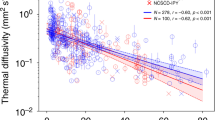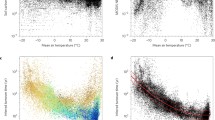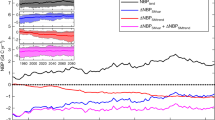Abstract
Organic matter significantly alters a soil’s thermal and hydraulic properties but is not typically included in land-surface schemes used in global climate models. This omission has consequences for ground thermal and moisture regimes, particularly in the high-latitudes where soil carbon content is generally high. Global soil carbon data is used to build a geographically distributed, profiled soil carbon density dataset for the Community Land Model (CLM). CLM parameterizations for soil thermal and hydraulic properties are modified to accommodate both mineral and organic soil matter. Offline simulations including organic soil are characterized by cooler annual mean soil temperatures (up to ∼2.5°C cooler for regions of high soil carbon content). Cooling is strong in summer due to modulation of early and mid-summer soil heat flux. Winter temperatures are slightly warmer as organic soils do not cool as efficiently during fall and winter. High porosity and hydraulic conductivity of organic soil leads to a wetter soil column but with comparatively low surface layer saturation levels and correspondingly low soil evaporation. When CLM is coupled to the Community Atmosphere Model, the reduced latent heat flux drives deeper boundary layers, associated reductions in low cloud fraction, and warmer summer air temperatures in the Arctic. Lastly, the insulative properties of organic soil reduce interannual soil temperature variability, but only marginally. This result suggests that, although the mean soil temperature cooling will delay the simulated date at which frozen soil begins to thaw, organic matter may provide only limited insulation from surface warming.













Similar content being viewed by others
References
Alexeev VA, Nicolsky DJ, Romanovsky VE, Lawrence DM (2007) An evaluation of deep soil configurations in the CLM3 for improved representation of permafrost. Geophys Res Lett 34. doi:10.1029/2007GL029536
Beringer J, Lynch AH, Chapin FS, Mack M, Bonan GB (2001) The representation of arctic soils in the land surface model: the importance of mosses. J Clim 14:3324–3335
Bonan GB, Shugart HH (1989) Environmental-factors and ecological processes in boreal forests. Annu Rev Ecol Syst 20:1–28
Burn CN, Nelson FE (2006) Comment on “A projection of near-surface permafrost degradation during the 21st century”. Geophys Res Lett 33:L21503. doi:10.1029/2006GL027077
Camill P (2005) Permafrost thaw accelerates in boreal peatlands during late-20th century climate warming. Clim Change 68:135–152
Campbell GS (1974) Simple method for determining unsaturated conductivity from moisture retention data. Soil Sci 117:311–314
Chapin FS, Sturm M, Serreze MC, McFadden JP, Key JR, Lloyd AH, McGuire AD, Rupp TS, Lynch AH, Schimel JP, Beringer J, Chapman WL, Epstein HE, Euskirchen LD, Hinzman LD, Jia G, Ping CL, Tape KD, Thompson CDC, Walker DA, Welker JM (2005) Role of land-surface changes in arctic summer warming. Science. doi:10.1126/science.1117368
Clapp RB, Hornberger GM (1978) Empirical equations for some soil hydraulic-properties. Water Resour Res 14:601–604
Collins WD, Rasch PJ, Boville BA, Hack JJ, McCaa JR, Williamson DL, Briegleb BP, Bitz CM, Lin S-J, Zhang M (2006) The formulation and atmospheric simulation of the community atmosphere model, version 3 (CAM3). J Clim 19:2144–2161
Cosby BJ, Hornberger GM, Clapp RB, Ginn TR (1984) A statistical exploration of the relationships of soil-moisture characteristics to the physical-properties of soils. Water Resour Res 20:682–690
Evans MG, Burt TP, Holden J, Adamson JK (1999) Runoff generation and water table fluctuations in blanket peat: evidence from UK data spanning the dry summer of 1995. J Hydrol 221:141–160
Farouki OT (1981) Thermal properties of soils. Report No. Vol. 81, No. 1, CRREL Monograph
Fraser CJD, Roulet NT, Moore TR (2001) Hydrology and dissolved organic carbon biogeochemistry in an ombrotrophic bog. Hydrol Processes 15:3151–3166
Global Soil Data Task (2000) Global gridded surfaces of selected soil characteristics (IGBPDIS). International Geosphere–Biosphere Programme—Data and Information Services. Available online [http://www.daac.ornl.gov/] from the ORNL Distributed Active Archive Center, Oak Ridge National Laboratory, Oak Ridge, Tennessee, USA
Harden JW, Manies KL, Turetsky MR, Neff JC (2006) Effects of wildfire and permafrost on soil organic matter and soil climate in interior Alaska. Glob Change Biol 12:2391–2403
Hinkel KM, Paetzold F, Nelson FE, Bockheim JG (2001) Patterns of soil temperature and moisture in the active layer and upper permafrost at Barrow, Alaska: 1993–1999. Glob Planet Change 29:293–309
Hinzman LD, Kane DL, Gieck RE, Everett KR (1991) Hydrologic and thermal-properties of the active layer in the Alaskan Arctic. Cold Reg Sci Technol 19:95–110
Hinzman LD, Bettez ND, Bolton WR, Chapin FS, Dyurgerov MB, Fastie CL, Griffith B, Hollister RD, Hope A, Huntington HP, Jensen AM, Jia GJ, Jorgenson T, Kane DL, Klein DR, Kofinas G, Lynch AH, Lloyd AH, McGuire AD, Nelson FE, Oechel WC, Osterkamp TE, Racine CH, Romanovsky VE, Stone RS, Stow DA, Sturm M, Tweedie CE, Vourlitis GL, Walker MD, Walker DA, Webber PJ, Welker JM, Winker K, Yoshikawa K (2005) Evidence and implications of recent climate change in northern Alaska and other arctic regions. Clim Change 72:251–298
Holland MM, Bitz CM (2003) Polar amplification of climate change in coupled models. Clim Dyn 21:221–232
Johanssen O (1975) Thermal conductivity of soils. University of Trondheim
Jorgenson MT, Shur YL, Pullman ER (2006) Abrupt increase in permafrost degradation in Arctic Alaska. Geophys Res Lett 2:L02503. doi:10:1029/2005GL024960
Lafleur PM, Hember RA, Admiral SW, Roulet NT (2005) Annual and seasonal variability in evapotranspiration and water table at a shrub-covered bog in southern Ontario, Canada. Hydrol Processes 19:3533–3550
Lawrence PJ, Chase TN (2007) Representing a new MODIS consistent land surface in the Community Land Model (CLM3.0). J Geophys Res 112. doi:10.1029/2006JG000168
Lawrence DM, Slater AG (2005) A projection of severe near-surface permafrost degradation during the 21st century. Geophys Res Lett 24:L24401. doi:10.1029/2005GL025080
Lawrence DM, Slater AG (2006) Reply to comment by C.R. Burn and F.E. Nelson on “A projection of near-surface permafrost degradation during the 21st century”. Geophys Res Lett 33:L21504. doi:10.1029/2006GL027955
Lawrence DM, Thornton PE, Oleson KW, Bonan GB (2007) Partitioning of evaporation into transpiration, soil evaporation, and canopy evaporation in a GCM: impacts on land–atmosphere interaction. J Hydrometeorol (in press)
Letts MG, Roulet NT, Comer NT, Skarupa MR, Verseghy DL (2000) Parametrization of peatland hydraulic properties for the Canadian Land Surface Scheme. Atmos Ocean 38:141–160
McGuire AD, Chapin FS, Walsh JE, Wirth C (2006) Integrated regional changes in Arctic climate feedbacks: implications for the global climate system. Annu Rev Environ Resour 31:61–91
Mölders N, Romanovsky VE (2006) Long-term evaluation of the hydro-thermodynamic soil-vegetation scheme’s frozen ground/permafrost component using observations at Barrow, Alaska. J Geophys Res D4. doi:10.1029/2005JD005957
Nicolsky DJ, Romanovsky VE, Alexeev VA, Lawrence DM (2007) Improved modeling of permafrost dynamics in Alaska with CLM3. Geophys Res Lett 34. doi:10.1029/2007GL029525
Niu GY, Yang ZL (2006) Effects of frozen soil on snowmelt runoff and soil water storage at a continental scale. J Hydrometeorol 7:937–952
Niu GY, Yang ZL, Dickinson RE, Gulden LE, Su H (2007) Development of a simple groundwater model for use in climate models and evaluation with GRACE data. J Geophys Res (submitted)
Oleson KW, Dai Y, Bonan G, Dickinson RE, Dirmeyer PA, Hoffman F, Houser P, Levis S, Niu G-Y, Thornton P, Vertenstein M, Yang Z-L, Zeng X (2004) Technical description of the Community Land Model (CLM). Report No. NCAR Tech. Note TN-461 + STR, National Center for Atmospheric Research, Boulder, CO
Osterkamp TE, Jorgenson JC (2006) Warming of permafrost in the Arctic National Wildlife Refuge, Alaska. Permafr Periglac Proc 17:65–69
Payette S, Delwaide A, Caccianiga M, Beauchemin M (2004) Accelerated thawing of subarctic peatland permafrost over the last 50 years. Geophys Res Lett 18:L18208. doi:10.1029/2004GL020358
Peters-Lidard CD, Blackburn E, Liang X, Wood EF (1998) The effect of soil thermal conductivity parameterization on surface energy fluxes and temperatures. J Atmos Sci 55:1209–1224
Qian T, Dai A, Trenberth KE, Oleson KW (2006) Simulation of global land surface conditions from 1948 to 2002: part I: forcing data and evaluations. J Hydrometeorol 7:953–975
Quinton WL, Gray DM (2003) Subsurface drainage from organic soils in permafrost terrain: the major factors to be represented in a runoff model. Eighth International Conference on Permafrost, Davos, p 6
Quinton WL, Gray DM, Marsh P (2000) Subsurface drainage from hummock-covered hillslopes in the Arctic tundra. J Hydrol 237:113
Serreze MC, Walsh JE, Chapin FS, Osterkamp T, Dyurgerov M, Romanovsky V, Oechel WC, Morison J, Zhang T, Barry RG (2000) Observational evidence of recent change in the northern high-latitude environment. Clim Change 46:159–207
Slater AG, Bohn TJ, McCreight JL, Serreze MC, Lettenmaier DP (2007) A multi-model simulation of Pan-Arctic hydrology. J Geophys Res Biogeosci (submitted)
Smith LC, Sheng Y, MacDonald GM, Hinzman LD (2005a) Disappearing Arctic lakes. Science 308:1429–1429
Smith SL, Burgess MM, Riseborough D, Nixon MF (2005b) Recent trends from Canadian permafrost thermal monitoring network sites. Permafr Periglac Proc 16:19–30
Stendel M, Christensen JH (2002) Impact of global warming on permafrost conditions in a coupled GCM. Geophys Res Lett 13. doi:10.1029/2001GL014345
Sturm M, McFadden JP, Liston GE, Chapin FS III, Racine CH, Holmgren J (2001) Snow–Shrub Interactions in Arctic Tundra: a hypothesis with climatic implications. J Clim 14:336–344
Sturm M, Schimel J, Michaelson G, Welker JM, Oberbauer SF, Liston GE, Fahnestock J, Romanovsky VE (2005) Winter biological processes could help convert arctic tundra to shrubland. Bioscience 55:17–26
Tape K, Sturm M, Racine C (2006) The evidence for shrub expansion in Northern Alaska and the Pan-Arctic. Glob Change Biol 12:686–702
Thornton PE, Rosenbloom NA (2005) Ecosystem model spin-up: Estimating steady state conditions in a coupled terrestrial carbon and nitrogen cycle model. Ecol Modell 189:25–48
Thornton PE, Zimmerman N (2007) An improved canopy integration scheme for a land surface model with prognostic canopy structure. J Clim (submitted)
Walter KM, Zimov SA, Chanton JP, Verbyla D, Chapin FS (2006) Methane bubbling from Siberian thaw lakes as a positive feedback to climate warming. Nature 443:71
Woo MK, Winter TC (1993) The role of permafrost and seasonal frost in the hydrology of Northern Wetlands in North-America. J Hydrol 141:5–31
Yi SH, Arain MA, Woo MK (2006) Modifications of a land surface scheme for improved simulation of ground freeze-thaw in northern environments. Geophys Res Lett 33
Zhang T, Barry R, Gilichinsky D (2001) Russian historical soil temperature data. Digital media. National Snow and Ice Data Center, Boulder
Zimov SA, Schuur EAG, Chapin FS (2006) Permafrost and the global carbon budget. Science 312:1612–1613
Zinke PJ, Stangenberger AG, Post WM, Emanuel WR, Olson JS (1986) Worldwide organic carbon and nitrogen data. ONRL/CDIC-18, Carbon Dioxide Information Centre, Oak Ridge, Tenessee
Acknowledgments
We would like to thank the Global Soil Data Task, the IGBP, ORNL DAAC and ISLSCP Initiative II for providing the soil carbon data. We would also like to thank Vladimir Romanovsky, Keith Oleson, and Larry Hinzman for helpful comments and suggestions as well as constructive comments from two anonymous reviewers. Funding support is provided by U.S. Department of Energy, Office of Biological and Environmental Research, cooperative agreement no. DE-FC03-97ER62402/A010 and National Science Foundation grants OPP-0229769 and OPP-0229651 and NASA NNG04GJ39G.
Author information
Authors and Affiliations
Corresponding author
Rights and permissions
About this article
Cite this article
Lawrence, D.M., Slater, A.G. Incorporating organic soil into a global climate model. Clim Dyn 30, 145–160 (2008). https://doi.org/10.1007/s00382-007-0278-1
Received:
Accepted:
Published:
Issue Date:
DOI: https://doi.org/10.1007/s00382-007-0278-1




